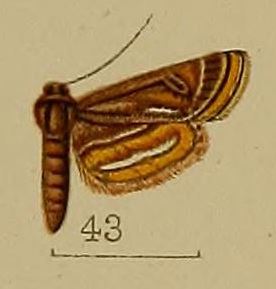
The Pyralidae, commonly called pyralid moths, snout moths or grass moths, are a family of Lepidoptera in the ditrysian superfamily Pyraloidea. In many classifications, the grass moths (Crambidae) are included in the Pyralidae as a subfamily, making the combined group one of the largest families in the Lepidoptera. The latest review by Eugene G. Munroe and Maria Alma Solis retain the Crambidae as a full family of Pyraloidea.
Merodictya is a monotypic moth genus of the family Crambidae described by William Warren in 1896. It contains only one species, Merodictya marmorata, described by Thomas Pennington Lucas in 1892, which is found in Australia, where it has been recorded from Queensland and New South Wales.
Mimudea is a genus of moths of the family Crambidae described by William Warren in 1892.
Mojavia is a monotypic moth genus of the family Crambidae erected by Eugene G. Munroe in 1961. It contains only one species, Mojavia achemonalis, which was first described by William Barnes and James Halliday McDunnough in 1914. It is found in North America, where it has been recorded from Arizona, California, Nevada, New Mexico and Texas.
Xanthophysa is a monotypic moth genus of the family Crambidae described by Eugene G. Munroe in 1964. It contains only one species, Xanthophysa psychialis, the xanthophysa moth, described by George Duryea Hulst in 1886. It is found in North America, where it has been recorded from Alabama, Florida, Illinois, Indiana, Kentucky, Maine, Mississippi, New Hampshire, New Jersey, North Carolina, Ohio, Ontario, Quebec, South Carolina and Tennessee.

Oligostigma is a genus of moths of the family Crambidae described by Achille Guenée in 1854.
Pyraustimorpha is a monotypic moth genus of the family Crambidae described by Ahmet Ömer Koçak and Selma Seven in 1995. It contains only one species, Pyraustimorpha inexpectata, which is found in Turkey.
Paracorsia is a monotypic moth genus of the family Crambidae described by H. Marion in 1959. It contains only one species, Paracorsia repandalis, described by Michael Denis and Ignaz Schiffermüller in 1775. It is found in most of Europe, except Ireland, Fennoscandia and the Baltic region. It has also been recorded from central Asia, including Iran and Kyrgyzstan and North America where it has been recorded in southern Ontario and northern Indiana.
Plateopsis is a monotypic moth genus of the family Crambidae described by William Warren in 1896. Its only species, Plateopsis vespertilio, described in the same article, is found in Meghalaya, India.
Prionopaltis is a genus of moths of the family Crambidae described by William Warren in 1892.
Rhectothyris is a genus of moths of the family Crambidae described by Warren in 1890.

Samea is a genus of moths of the family Crambidae described by Achille Guenée in 1854.

Schacontia is a genus of moths of the family Crambidae described by Harrison Gray Dyar Jr. in 1914.
Sericophylla is a monotypic moth genus of the family Crambidae described by Alfred Jefferis Turner in 1937. Its only species, Sericophylla nivalis, described in the same paper, is found in Australia, where it has been recorded from Queensland.

Tabidia is a genus of moths of the family Crambidae described by Pieter Cornelius Tobias Snellen 1880.
Tanaophysa is a genus of moths of the family Crambidae described by William Warren in 1892.

Tetridia is a monotypic moth genus of the family Crambidae described by William Warren in 1890. Its single species, Tetridia caletoralis, was described by Francis Walker in 1859. It is found in China, northern India, Sri Lanka, Myanmar, Malaysia, Papua New Guinea, Japan, Taiwan and Australia, where it has been recorded from Queensland.
Agassiziella hapilista is a moth in the family Crambidae first described by Charles Swinhoe in 1892. It is found in India, where it has been recorded from the Khasi Hills. It is also present in Taiwan.
Pyrausta coccinea is a moth in the family Crambidae. It was described by William Warren in 1892. It is found in North America, where it has been recorded from California.
Udea indistinctalis is a moth in the family Crambidae. It was described by William Warren in 1892. It is found in North America, where it has been recorded from Alberta, Saskatchewan, Washington and California.




